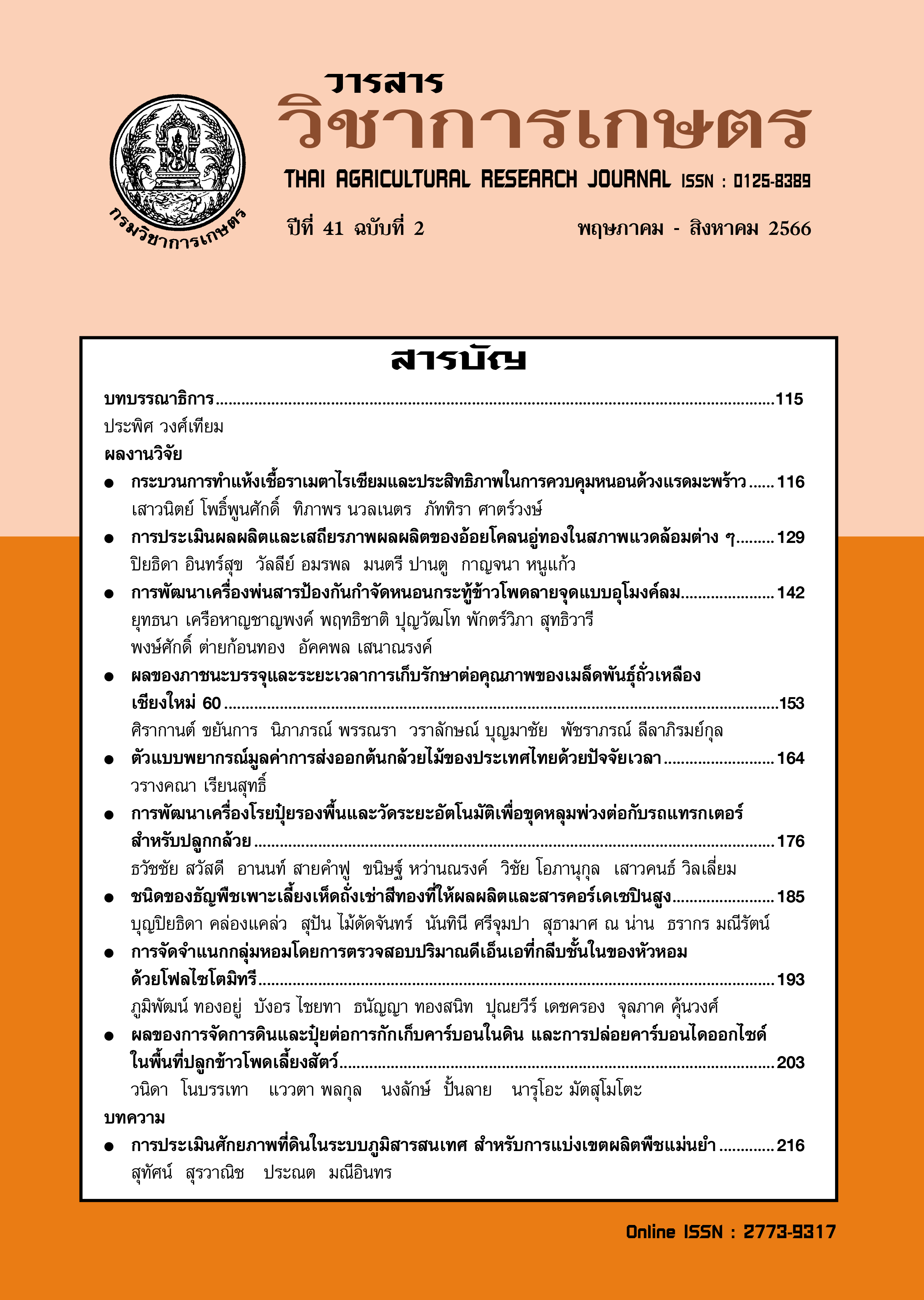การประเมินศักยภาพที่ดินในระบบภูมิสารสนเทศ สำหรับการแบ่งเขตผลิตพืชแม่นยำ
DOI:
https://doi.org/10.14456/thaidoa-agres.2023.19คำสำคัญ:
การประเมินศักยภาพที่ดินด้วยหลายปัจจัยระบบสารสนเทศทางภูมิศาสตร์, ปัจจัยการผลิตที่พืชต้องการ, ขีดจำกัดของการผลิตพืช, ประมวลผลตามลำดับชั้นเชิงวิเคราะห์, การประเมินศักยภาพบทคัดย่อ
การขยายพื้นที่ปลูกปาล์มน้ำมันจากแหล่งปลูกเดิมไปยังแหล่งปลูกใหม่ และการตัดสินใจเลือกพื้นที่ปลูกต้องการข้อมูลสนับสนุนการเลือกพื้นที่ที่เหมาะสมเป็นขั้นตอนแรกที่ สำคัญมากต่อการผลิต พื้นที่ที่เหมาะสมต้อง ประกอบไปด้วยปัจจัยดินที่จำเป็นต่อการผลิตพืช และปัจจัยสภาพอากาศที่จำเป็นต่อการผลิตพืช ความเหมาะสมของพื้นที่สามารถวิเคราะห์สำรวจได้โดยวิธีการประเมินศักยภาพที่ดิน ดังนั้นการเพิ่มประสิทธิภาพและความแม่นยำของการประเมินศักยภาพที่ดิน ด้วยการประมวลผลตามลำดับชั้นเชิงวิเคราะห์ (Analytical Hierarchical
Processing: AHP) ร่วมกับวิธีการเปรียบเทียบแบบคู่แพไวร์คอมแพริสัน (Pairwise Comparison Method) จึงได้รับการพัฒนาขึ้นโดยใช้ระบบสารสนเทศภูมิศาสตร์ (GIS) และได้นำมาใช้เป็นเครื่องมือจัดทำเป็นพื้นที่เหมาะสมต่อการปลูกปาล์มน้ำมันในภาคใต้ และการขยายพื้นที่ปลูกปาล์มน้ำมันจากแหล่งปลูกเดิมไปยังแหล่งปลูกใหม่ ในกรณีศึกษาการปลูกปาล์มน้ำมัน ได้เลือกพื้นที่ จ.กาญจนบุรี ด้วยสมมติฐานว่า พื้นที่ที่มีปัจจัยที่จำเป็นต่อการผลิตเช่นเดียวกับภาคใต้พื้นที่นั้นจะให้ผลผลิตในระดับเดียวกัน ผลการศึกษาได้แผนที่รูปแบบจำลองพยากรณ์ผลผลิตปาล์มน้ำมัน จ.กาญจนบุรี ที่สามารถระบุพื้นที่เหมาะสมต่อการปลูกปาล์มน้ำมัน (P1) ที่มีศักยภาพให้ผลผลิตมากกว่า 3 ตัน/ไร่/ปีส่วนใหญ่กระจายอยู่ในบริเวณที่ราบลุ่ม อ.สังขละ ทองผาภูมิ และไทรโยค รวม 606,628 ไร่ และพื้นที่เหมาะสมปานกลางต่อการปลูกปาล์มน้ำมัน (P2) ที่มีศักยภาพให้ผลผลิตระหว่าง 2.5-3 ตัน/ไร่/ปี ส่วนใหญ่กระจายอยู่ในพื้นที่ราบลุ่มของ อ.สังขละ ทองผาภูมิ และไทรโยค รวม 564,512 ไร่
เอกสารอ้างอิง
นคร สาระคุณ สมยศ สินธุระหัส และสุทัศน์ ด่านสกุลผล. 2541. วิเคราะห์ความเหมาะสมของพื้นที่ปลูกปาล์มน้ำมันในภาคใต้ของประเทศไทย. สถาบันวิจัยพืชสวน, กรมวิชาการเกษตร. 266 หน้า.
สุทัศน์ สุรวาณิช. 2560. การประเมินศักยภาพพื้นที่ในการผลิตพืช ด้วยระบบสารสนเทศทางภูมิศาสตร์. หน่วยที่ 15. หน้า 15-1 - 15-81.ใน เอกสารการสอนชุดวิชาการจัดการการผลิตพืชไร่อุตสาหกรรม. ฉบับปรับปรุงครั้งที่ 1. มหาวิทยาลัยสุโขทัยธรรมาธิราช.
สุทัศน์ สุรวาณิช. 2561. ภูมิอากาศและการจัดการการเกษตร ป่าไม้ และสิ่งแวดล้อม. หน่วยที่ 7. หน้า 7-1 - 7-67. ใน เอกสารการสอนชุดวิชา เทคโนโลยีเพื่อการจัดการ ทรัพยากรเกษตร ทรัพยากรธรรมชาติ และสิ่งแวดล้อม. พิมพ์ครั้งที่ 1 มหาวิทยาลัยสุโขทัยธรรมาธิราช.
Dansagoonpon, S. 2006. Crop Substitution Modeling Using Remote Sensing and GIS. A dissertation submitted in partial fulfillment of the requirements for the degree of doctor of technical science (Remote Sensing & GIS), school of engineering and technology, Asian Institute of Technology, Thailand. 154 p.
Dansagoonpon, S. and K.T. Nitin. 2006. Modeling Site Suitability for Oil Palm Plantations in Southern Thailand. GIScience & Remote Sensing. 43(3): 252–267.
FAO.1976. A Framework for Land Evaluation. Soil Bulletin 32. Rome, Italy. 72 p.
Saaty, T.L. 1990. Multi Criteria Decision Making-The Analytic Hierarchy Process. RWS Publication, Ellsowrth Avenue, USA.
Sinthurahat, S. 1992. Elaboration of Land Evaluation Model of Rubber Cultivation in Peninsular Thailand. Ph.D Thesis University of Ghent, Belgium. 261 p.
Sys, C. 1974. The Pedology of Rubber. International Training Center for Post-Graduate Soil Scientists (ITC), State University of Ghent, Belgium. 24 p.
Sys, C. 1992. Land Evaluation. Part I to III. International Training Center for Post-Graduate Soil Scientists (ITC), State University of Ghent, Belgium. 125 p.
Sys, C., E. Van Ranst, and J. Debaveye. 1992. Land Evaluation. Part I (Principles in Land Evaluation and Crop Production Calculation). International Training Center (ITC) for Post-Graduate Soil Scientists. State University of Ghent, Belgium. 274 p.
ดาวน์โหลด
เผยแพร่แล้ว
รูปแบบการอ้างอิง
ฉบับ
ประเภทบทความ
สัญญาอนุญาต
ลิขสิทธิ์ (c) 2023 วารสารวิชาการเกษตร

อนุญาตภายใต้เงื่อนไข Creative Commons Attribution-NonCommercial-NoDerivatives 4.0 International License.
วารสารวิชาการเกษตร



